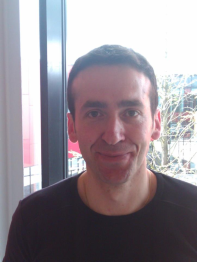Biomicrofluidic Chemoemmiter System: Towards pheromone communication
Promotion date: 27. April 2012
Promotor: Prof. dr. Han Gardeniers
| Functional equivalents of the molecular, subcellular and cellular machinery that are found in insect pheromone communication serve as inspiration for this research. The microfluidic platform forms the basis for a new branch of information technology for communicating chemicals over space and in time, using mixtures of infochemical ligands (i.e. pheromones) in precisely controlled ratios of concentrations to encode information.
|
So, you were inspired by nature in a special way during your thesis research!
The odour communication used by insects, in this case moths (Spodoptera littoralis), is as complex as in humans. The chemical synthesis of pheromones is a subtle process in which one micro compartment contains a specific type of cells. The moths can release from these compartments different ratios of pheromone mixtures. These are transported through the air. Male butterflies can then detect these mixtures in low damp concentrations, by setting into work specific receptors. It is a unique communication tool for them in finding attractive partners.
Pheromones are used by many different species, for instance ants and bees set invisible paths to find back the nest area. Also the pheromones are used as a stress signal, telling ants to help save their fellows or in some cases to stay away from danger. Quite subtle messages are sent in nature conditions that are not well characterized yet.
The microreactor we constructed for this purpose, is able to evaporate these kinds of pheromone volatiles in a controlled way, mixing different ratios and controlling them temporally as well. So, we can deliver these mixtures easily in space and time.
During the experiments I really got close to nature, as close as a laboratory can allow. The pheromones are really aromatic and possess a fruity smell. In Barcelona, together with the colleagues from the CSIC institute, we performed insect behavioural tests in the wind tunnel. It was proven that the moths actually were attracted to the pheromone mixtures, released from the microfluidic platform and carried by a wind stream.
Was your research of a fundamental nature or also application driven?
Using the different ratios as an information carrier is a totally novel approach, involving basic knowledge but also involving practical implications, for example in information technology. Of course, a practical application in this branch will take several years from now.
However, etymologists can develop new experiments by using this microfluidic devices as a tools that will allow to explore purified enzymes in nearly environmental conditions. Here, practical applications seem rather obvious in near future.
Was there a special moment you recall, during your project?
When the reactor finally worked, I was extremely happy. Some bottlenecks appeared during the project as pheromone compounds appeared to react with silicon in a strange and uncontrollable way. A new type of PEM-based coating was developed to avoid these problems. Here, the input of the lab-technicians and an intern student was very important.
In the very moment the device was functioning as expected, I was very eager to prove its reproducibility. Unfortunately, I had to wait one long week to be able to do so. The cleanroom steps took some time and also I had to attend all kinds of project meetings. In this week I was not paying all the attention needed, I am afraid.
How did you develop personally as a researcher and scientist?
After this PhD project, I am convinced once more that one cannot perform complex research like this on his own. I met brilliant researchers along the way within MESA+ and also from abroad, like professor Angel Guerrero from Barcelona, professor Julian Gardner from Leicester and also colleagues from Warwick and Jena.
What are your future plans?
Right now, I am working as a post-doc at Dublin City University and the Biomedical Diagnostic Institute, on a microfluidic project for early diagnostic of cancer. Here, I am able to develop my skills even further.
I like being able to follow my own ideas, feeling good about my performances at the end of the day. And, of course, I always hope that the findings are of practical use, for example in diagnostics and thus make a contribution to society.
What, in your opinion, is important for Mesa+ to stay successful in future?
Mesa+ is on the right track, that is for sure. In Dublin they are highly ranked as a renowned institute bringing about spin-off companies possessing great potential.
The cleanroom facilities and expertise, I enjoyed and appreciated greatly. For example, the database of microfluidic fabrication technologies is an immense library for applied science of great value for future applications at various fields.

